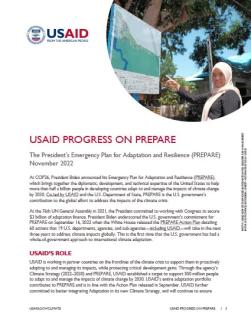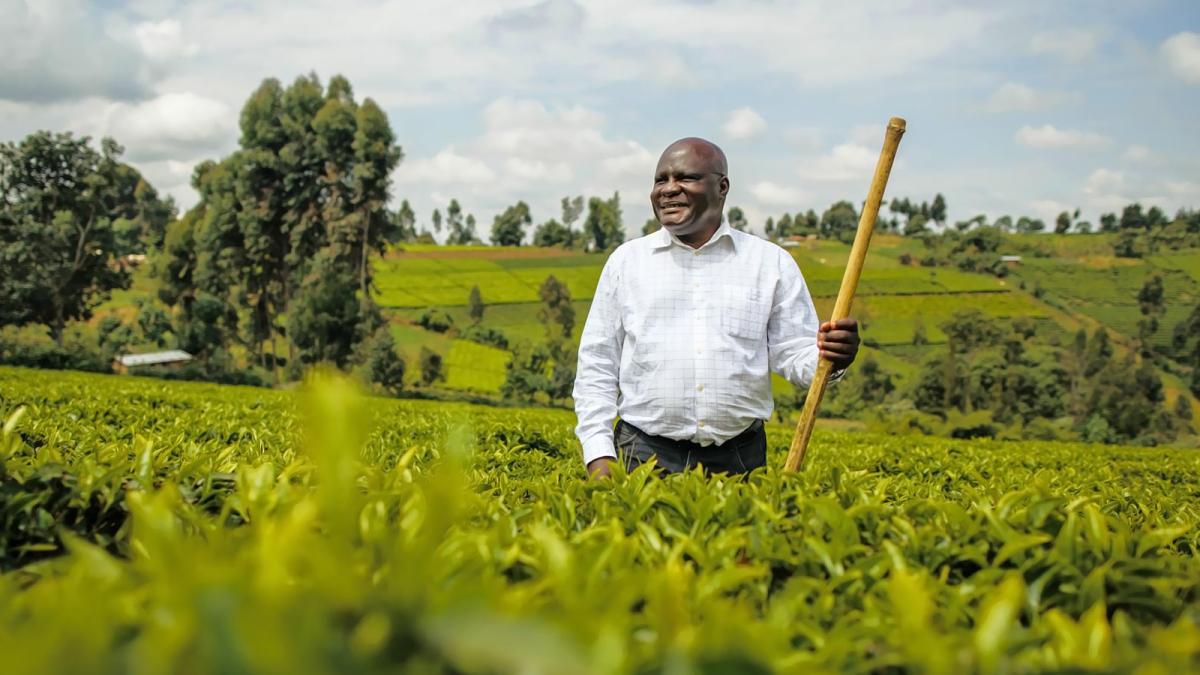The President’s Emergency Plan for Adaptation and Resilience (PREPARE)
Co-led by USAID and the U.S. Department of State, PREPARE is the U.S. government’s contribution to the global effort to address the impacts of the climate crisis.
At COP26, President Biden announced his Emergency Plan for Adaptation and Resilience (PREPARE), which brings together the diplomatic, development, and technical expertise of the United States to help more than half a billion people in developing countries adapt to and manage the impacts of climate change by 2030. Co-led by USAID and the U.S. Department of State, PREPARE is the U.S. government’s contribution to the global effort to address the impacts of the climate crisis.
At the 76th UN General Assembly in 2021, the President committed to working with Congress to secure $3 billion of adaptation finance. President Biden underscored the U.S. government’s commitment for PREPARE on September 16, 2022 when the White House released the PREPARE Action Plan detailing 60 actions that 19 U.S. departments, agencies, and sub-agencies—including USAID—will take in the next three years to address climate impacts globally. This is the first time that the U.S. government has had a whole-of-government approach to international climate adaptation.
USAID’s Role
USAID is working in partner countries on the frontlines of the climate crisis to support them in proactively adapting to and managing its impacts, while protecting critical development gains. Through the agency’s Climate Strategy (2022–2030) and PREPARE, USAID established a target to support 500 million people to adapt to and manage the impacts of climate change by 2030. USAID’s entire adaptation portfolio contributes to PREPARE and is in line with the Action Plan released in September. USAID further committed to better integrating Adaptation in its new Climate Strategy, and will continue to ensure USAID’s work on food security, water, health, infrastructure, disaster risk reduction, and humanitarian response continues to build and incorporate principles that result in better climate resilience. In addition, USAID addresses climate risk throughout its climate risk management process. At COP27, USAID is proud to share the progress it has made over the past year.
Climate risk management and adaptation can be thought of functioning on a continuum. Preparing for climate impacts is a primary objective of climate adaptation work, such as that being done under PREPARE. Climate risk management (CRM) is the process of assessing, addressing and adaptively managing climate risks that may impact the ability of USAID programs to achieve objectives, and thereby also facilitates resilience to both current and future climate.
Achievements to Date
Pillar 1 of PREPARE: Knowledge: Information is Power
USAID works with country governments, scientists, civil society, and other stakeholders to support communities with actionable climate information. This includes early warning systems, disaster risk reduction, and ensuring healthcare providers and smallholder farmers alike know and can plan for impacts that are coming. Over the past year, USAID has expanded access to life- and livelihood-saving climate information for local communities in Central America, West Africa, East Africa, South Asia, and Southeast Asia through SERVIR, the USAID-NASA partnership to inform climate and development decisions with space and ground data.
Pillar 2 of PREPARE: Plans and Programs: Mainstream and Integrate Adaptation, Build Relationships, Execute
Through targeted programs and day-to-day engagements of USAID Missions with country governments, USAID works with countries around the world to mainstream and integrate adaptation into their policies and programs, build out their National Adaptation Plans (NAPs) and the adaptation components of their Nationally Determined Contributions (NDCs), and set concrete implementation and budgeting plans. In support of this work, USAID has taken the following actions over the past year:
- USAID Missions in 12 countries are engaged in USAID’s new Comprehensive Action for Climate Change Initiative (CACCI), including Bangladesh, Brazil, Colombia, Ghana, Guyana, Nepal, Peru, Rwanda, Senegal, Suriname, Tajikistan, and Zambia.
- USAID launched the Climate Adaptation Support Activity (CASA) to advance equitable and impactful climate adaptation mainstreaming, programming, and scaling that improves the resilience of people and systems in support of the adaptation goals of USAID’s climate strategy.
- USAID launched a new activity to protect critically biodiverse areas in Bangladesh from environmental degradation and climate impacts.
- USAID launched several new public-private partnerships supporting adaptation that collectively leverage over $20 million of private sector funds under the Health, Ecosystems, and Agriculture for Resilient Thriving Societies (HEARTH) umbrella. They include the ACTIVE partnership in Indonesia, through which USAID is partnering with Mars to support smallholder farmers to improve their productivity and livelihoods through climate-smart agricultural practices.
- USAID is investing $1.8 million to galvanize new public-private partnerships addressing food loss and waste in countries hit particularly hard by the current global food price crisis.
- USAID joined the recently launched Alliance on Transformative Action on Climate and Health to partner with others in supporting countries in achieving their commitments.
Pillar 3 of PREPARE: Resources: Mobilize Finance and Private Capital
USAID is engaged in catalyzing private sector investment in adaptation, increasing local access to adaptation finance, and improving developing countries’ access to climate finance. USAID recognizes addressing adaptation gaps requires the engagement of donors, governments, private companies, local businesses, and civil society. Over the past year, USAID has taken the following actions:
- Building upon USAID’s COP26 commitments, USAID continues to be a strong advocate and supporter of disaster risk finance. As one example of our current investments, USAID funded drought insurance for Mali and Burkina Faso for the past two years. Due to catastrophic drought in the Sahel, these drought insurance policies have been triggered meaning that an additional $12 million of disaster relief goes to drought-stricken farmers in Mali, and $7 million in Burkina Faso in 2022–2023. USAID’s investments in the African Risk Capacity’s Replica coverage also supported Madagascar and Mozambique in disaster risk management (including the option to buy cyclone and drought insurance), and a feasibility study in Sudan this past year.
- USAID launched WASH-FIN 2.0, a water and sanitation finance program, to support the COP26 commitment to mobilize $1 billion in climate-resilient water and water, sanitation, and hygiene (WASH) funding by 2030. So far, USAID Missions in the Philippines, Nigeria, Indonesia, and Mozambique are working to implement programs that advance climate-resilient water and WASH.
- USAID launched the Climate Finance for Development Accelerator (formerly the Green Recovery Investment Platform, GRIP), which aims to mobilize $2.5 billion of private and public finance for adaptation and mitigation by 2030.
- The U.S. government, represented by USAID and the State Department, is engaging in the Taskforce on Access to Climate Finance, which was convened by the United Kingdom and Fiji at COP26. USAID is working closely with Jamaica, one of five ‘pioneer’ countries testing and modeling new approaches developed by the Taskforce.
- USAID is working with the State Department to galvanize private sector engagement through the PREPARE Call to Action to the Private Sector. USAID is also working with other U.S. government agencies on the localization of climate finance and improving access to the Green Climate Fund.
PREPARE Implementation in Action
Adaptation on Top of the World in Nepal
In Nepal, subsistence farmers using rainfed agricultural practices are increasingly unable to grow traditional crops due to climate-induced changes to precipitation patterns. USAID’s support for climate-smart agriculture practices and water management enable those same farmers to continue to thrive, expand their businesses, and support their families.
Read more: https://www.climatelinks.org/blog/adaptation-top-world
Moving Forward
Marshaling the Full Capability of the U.S. Government in Support of PREPARE
USAID continues to co-lead the U.S. government’s work on PREPARE. Over the next year, USAID plans to continue to expand its work on mobilizing private finance for climate adaptation, including in support of small- and medium-sized enterprises; deepen interagency engagement on issues of inclusion and co-development of climate information services; and continue implementation of adaptation programs globally.



